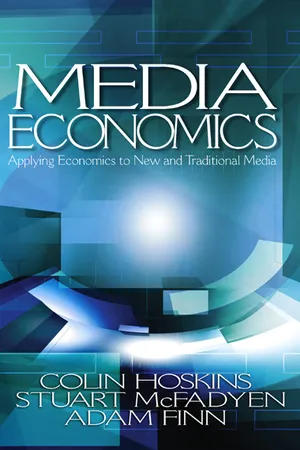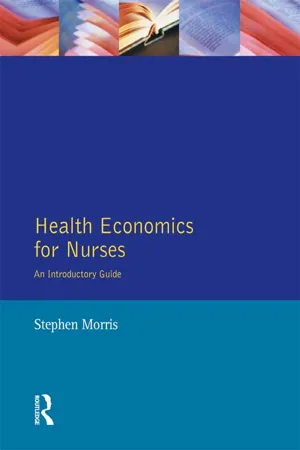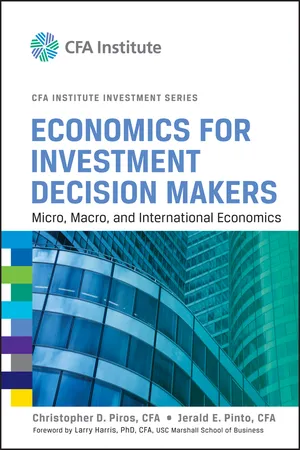Economics
Shifts in Supply
Shifts in supply refer to changes in the quantity of a good or service that producers are willing and able to supply at different price levels. These shifts can be caused by factors such as changes in input prices, technology, expectations, or the number of suppliers in the market. When supply shifts, it results in a new supply curve, reflecting the new relationship between price and quantity supplied.
Written by Perlego with AI-assistance
Related key terms
7 Key excerpts on "Shifts in Supply"
- No longer available |Learn more
Contemporary Economics
An Applications Approach
- Robert Carbaugh(Author)
- 2016(Publication Date)
- Routledge(Publisher)
- According to the law of supply, sellers are willing and able to make more of their product available at a higher price than a lower price, all other determinants of supply being constant. The tendency for the cost of additional output to increase explains the law of supply.
- A supply shifter is a variable that causes a shift in a supply curve. Among the major supply shifters are resource prices, technology, the prices of other goods, expected future prices, taxes and subsidies, and the number of suppliers. When a supply shifter results in an increase in supply, the supply curve shifts to the right; a decrease in supply shifts the supply curve to the left.
- In a competitive market, equilibrium occurs when the price of a product adjusts so that the quantity that consumers will purchase at that price is identical to the quantity that suppliers will sell. The price at which buyers’ intentions are equal to sellers’ intentions is called the equilibrium price. A surplus of a product causes the price to fall to its equilibrium level; a shortage of a product causes the price to rise to its equilibrium level.
- eBook - ePub
Media Economics
Applying Economics to New and Traditional Media
- Colin Hoskins, Stuart M. McFadyen, Adam Finn(Authors)
- 2004(Publication Date)
- SAGE Publications, Inc(Publisher)
chapter 14 .3.4 Change in SupplyA change in the value of one of the determinants of supply other than own price causes a change in supply . Economists use this term to avoid confusion with change in quantity supplied , which is caused by a change in the price of the product itself. If there is a change in supply, this causes a shift of the entire supply curve. If there is an increase in supply, the supply curve will shift to the right, as more will be supplied than before at any given price. If there is a decrease in supply, the supply curve will shift to the left, indicating that less will be supplied at any given price.3.5 Effect of Change in Supply on Price and QuantityA change in supply causes the equilibrium price to change in the opposite direction to the change in supply. In contrast, the equilibrium quantity changes in the same direction as the change in supply. Figure 3.4 illustrates an increase in supply from S0 to S1 , resulting in a decrease in equilibrium price from P0 to P1 and an increase in equilibrium quantity from Q0 to Q1 . Figure 3.5 shows a decrease in supply from S2 to S3 , causing the equilibrium price to increase from P2 to P3 and the equilibrium quantity to decrease from Q2 to Q3 .Figure 3.4 An Increase in SupplyNote: D indicates demand curve; P, price; Q, quantity; S, supply curve.Figure 3.5 A Decrease in SupplyNote: D indicates demand curve; P, price; Q, quantity; S, supply curve.3.6 Causes of a Change in SupplyA change in supply is caused by a change in the value of any determinant other than own price. Key determinants are the prices of inputs , the state of technology , and the number of suppliers .3.6.1 Prices of InputsInput prices directly affect the cost of producing the industry output. A decrease in input price makes it less expensive to produce output, and firms will be willing to supply more at any given product price. Hence a decrease in input price will increase supply and shift the supply curve to the right, as in Figure 3.4 . Similarly, an increase in input price will decrease supply and shift the supply curve to the left, as in Figure 3.5 - eBook - ePub
- Andrew Barkley, Paul W. Barkley(Authors)
- 2016(Publication Date)
- Routledge(Publisher)
Change in Supply = a change in the supply of a good due to a change in an economic variable other than the price of the good. A shift in the supply curve.Figure 8.8 shows a change in supply.A rightward shift in the supply curve represents an increase in supply, since more hamburgers will reach the market at each price. Similarly, a shift in the supply curve to the left would show a decrease in supply (fewer hamburgers at each price). The increase in supply in Figure 8.8 could result from an increase in the technology available to the firm, or a decrease in production costs. Shifts in the entire supply function represent a change in nonprice determinants of supply. The following section explains these supply determinants.8.4 Determinants of supply
The supply of a good results from the interaction of many economic variables. The list of supply determinants generally considered to be most important includes such things as: (1) input prices, (2) production technology, (3) prices of related goods, and (4) the number of sellers. Therefore, a formula for a supply curve for a good includes own price (P), input prices (Pi ), technology (T), prices of other, related goods (Po ), the number of sellers (N), and a category “Other,” representing all other determinants of supply:(8.15) Qs = f(P | Pi , T, Po , N, Other).Figure 8.8 An increase in the supply of hamburgers in Elko, NevadaA graph of a supply curve condenses all of the determinants into the relationship between the quantity supplied of a good (Qs ) and the own price of the good (P), while all other variables are held constant (the ceteris paribus assumption).Quick Quiz 8.7
Why are all variables other than the price held constant?The nonprice determinants of supply are often called “supply shifters” because a change in any one of them results in a shift in the entire supply curve (a change in supply). However, if only the price of a good changes, the result is a movement along the existing supply curve, or a change in quantity supplied. - eBook - ePub
- Rob Dransfield(Author)
- 2013(Publication Date)
- Routledge(Publisher)
The expectation that prices will change in the future will also affect the demand for a product. For example, if people think that prices are due to rise shortly they will want to hoard goods to protect themselves against the rise. For example, in years when winter weather is particularly bad householders may stock up with food supplies in anticipation of heavy snow.Changes in the conditions of supplyThe cost of producing an item is determined by the price of the various inputs, including the raw materials and machinery used to make it. Rises in the prices of some resource inputs will increase production costs, which in turn will result in a reduction in supply at each prise rise (see Figure 3.6 ). The supply curve will shift to the left when, at any given price, fewer items are produced and offered for sale.Causes of changes in supply conditions There are several factors that can cause changes in supply:Figure 3.6 The effect of a shift in the supply curve to the left- Rising or falling production costs
- Changes in technology
- Changes in physical conditions
- Changes in taxation and subsidies
- Changes in joint supply conditions
- Changes in the number of producers
This can be explained by an appeal to common sense – following a rise in production costs firms will produce less at the same selling price in order to preserve revenues; similarly, at lower production costs firms are able to produce more at the same selling price.Rising resource prices lead to rising production costs. War and conflict can restrict the supply of important resources such as oil and can lead to rapid increases in product costs. Production costs fall when the price of resources falls. So when the price of oil falls, energy costs for all industries are reduced. - eBook - ePub
Health Economics For Nurses
Intro Guide
- Stephen Morris(Author)
- 2014(Publication Date)
- Routledge(Publisher)
7. By supply we mean the quantity of a good that producers will wish to offer for sale at a particular price per time period. 8. The quantity supplied of a good is also influenced by a number of variables, such as the price of the good, the prices of other goods and the costs of production. 9. There is, in general, a positive relationship between the price of a good and the quantity supplied of that good. 10. The supply curve may be derived using the Law of Increasing Costs and the assumption that producers wish to maximise their profits. 11. The equilibrium price is the price at which the wishes of consumers and producers coincide.12. If the market price is different from the equilibrium price, then either an upward or downward pressure on price, exerted by market forces and caused by excess demand or excess supply, will cause the market price to tend towards the equilibrium price.13. Changes in the demand and supply curves, caused by changes in the determinants of demand and supply, will cause the equilibrium price to change. 14. There are four basic changes which can occur to the equilibrium price: a rise in demand; a fall in demand; a rise in supply; and a fall in supply. 15. The intuitive reason for using the market framework to address the issue of scarcity is that markets provide a means of allocating resources which is efficient.16. Aiming to maximise their utility, consumers will spend the amount of money which will maximise their well-being, resulting in allocative efficiency. At the same time, producers, seeking to maximise their utility through maximising their profits, will compete for custom by producing goods most highly valued by consumers at least cost, thus behaving in a technically efficient manner.17. Consumers in the market have the knowledge and ability to determine the level of price at which demand equals supply. The dominance of consumer preferences is known as consumer sovereignty, and is a necessary condition for the market to allocate resources efficiently. - eBook - ePub
The Industrial System (Routledge Revivals)
An Inquiry into Earned and Unearned Income
- J. Hobson(Author)
- 2013(Publication Date)
- Routledge(Publisher)
in the amount of money consumers are willing and able to pay for a supply of goods at the current price, will, through causing a larger or a smaller supply to be produced, alter the methods of production, the positive and relative amounts of the various factors of production, and the prices that are paid per unit for their use, so raising and lowering the margins of employment, extensive and intensive, of each factor. Still more important are the influences which the rise or fall of demand prices for staple materials of manufacture exert upon the structure of whole groups of trades, and so upon the supply prices of the goods they make. The rise of demand prices for such articles as copper, rubber, oil, paper, leather, due to new or increased demands for electric apparatus, motors, cheap literature, &c., have altered the economic and even the political administration of whole provinces. § 6.—The elasticity of supply, i.e. the response which expenses of production make to a rise or a fall of demand at previous prices, is much less calculable than the elasticity of demand. For, whereas the latter commonly depends upon the gradual action of large bodies of consumers altering their habits of consumption, the former is usually achieved by quick changes in methods of production spreading rapidly over whole trades of producers. Production is normally less conservative than consumption, and is more alert to seize and adopt new economies. For though habits of industry make for themselves deep grooves, and labour, capital, and ability, being specialised in certain methods, resist innovations which, however beneficial in the long run, involve present trouble and loss, competition forces reforms - eBook - ePub
Economics for Investment Decision Makers
Micro, Macro, and International Economics
- Christopher D. Piros, Jerald E. Pinto(Authors)
- 2013(Publication Date)
- Wiley(Publisher)
CHAPTER 1
DEMAND AND SUPPLY ANALYSIS: INTRODUCTION
Richard V. Eastin Gary L. Arbogast, CFALEARNING OUTCOMES
After completing this chapter, you will be able to do the following:- Distinguish among types of markets.
- Explain the principles of demand and supply.
- Describe causes of shifts in and movements along demand and supply curves.
- Describe the process of aggregating demand and supply curves, the concept of equilibrium, and mechanisms by which markets achieve equilibrium.
- Distinguish between stable and unstable equilibria and identify instances of such equilibria.
- Calculate and interpret individual and aggregate demand and inverse demand and supply functions, and interpret individual and aggregate demand and supply curves.
- Calculate and interpret the amount of excess demand or excess supply associated with a nonequilibrium price.
- Describe the types of auctions and calculate the winning price(s) of an auction.
- Calculate and interpret consumer surplus, producer surplus, and total surplus.
- Analyze the effects of government regulation and intervention on demand and supply.
- Forecast the effect of the introduction and the removal of a market interference (e.g., a price floor or ceiling) on price and quantity.
- Calculate and interpret price, income, and cross-price elasticities of demand, and describe factors that affect each measure.
1. INTRODUCTION
In a general sense, economics is the study of production, distribution, and consumption and can be divided into two broad areas of study: macroeconomics and microeconomics. Macroeconomics deals with aggregate economic quantities, such as national output and national income. Macroeconomics has its roots in microeconomics
Index pages curate the most relevant extracts from our library of academic textbooks. They’ve been created using an in-house natural language model (NLM), each adding context and meaning to key research topics.






